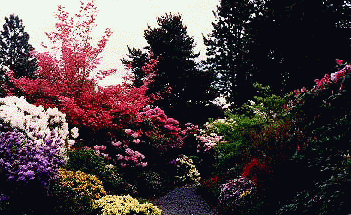 |
The Anderson Garden, like any garden, is not a copy of nature, but an arrangement of nature to suggest certain things about the natural world from the perspective of the designer. The garden style is a product of the designer's individual differences, experiences, historical/cultural roots, and talent. Gardens fall on a continuum from the rigidly formal, such as the geometric gardens of Europe, to the subtle reflections of natural landscapes in a Japanese garden. The Anderson Garden is closer to the Japanese, but with some European and American influences. |
|
After receiving his landscape architecture degree from Penn State in the early 1930s, Bob boarded a freighter to bicycle around Europe. The French and Italian gardens suggested to him a taming of nature, civilizing unruly wilds with order. Garden sculptures accented the precise plantings. The English estate gardens he visited, featuring the collecting and hybridizing of 19th Century rhododendron pioneers, recreated native landscapes of a world empire on gentry estates. Meanwhile, English country gardens of the common people splashed with color, with masses of flowers planted close in spontaneous confusion. |
After World War II, Bob created the first Anderson Garden on a lakeside forest in Springfield, New Jersey. His education and trip influenced his development of eight wooded acres into a rhododendron park. He built the house out of local stone dug to make room for the plants, and included a small geometric garden with brick walkways and patio attached to the house. Away from the house, broad meandering grass paths led the visitor around large rhododendron beds. Many of the specimens were indigenous plants that he shipped up by the boxcarload from the Appalachian Mountains of Virginia and his native North Carolina. In 1961, Bob and Betty, then in their fifties, sold the New Jersey garden and started from scratch in the Pacific Northwest, 3000 miles away. They bought a hayfield in Enumclaw, Washington, between Puget Sound and the Cascade Mountains. |
Because of their location on the Pacific Rim, Washington gardens were more strongly influenced by Asia, and by Japan in particular, than those in the Atlantic states. The northwest had many public Japanese gardens, and the climate supported many Japanese plants. In Japanese gardens, various elements suggest in small scale features of the natural world, such as mountains, rivers, and forests. Water flows in ponds, creeks, and waterfalls rather than fountains. Color variation is subdued and minimal, with few flowers. These gardens are designed for contemplation rather than for entertaining. The influences of Japanese gardening permeate the Anderson Garden. |
| |
| Bob began creating the second Anderson Garden and house in 1961. Instead of a stone house in the European and early American tradition, he designed one of northwest cedar, with a hip roof found both in Japanese temples and Dutch houses. Like the New Jersey garden, it featured brick pattern walks and patio around the house. A large circle of grass forms the transition between the geometry of the house and the natural shapes of the garden. | The Anderson Garden, as described in other sections of Design Elements, is a collection of curving paths and beds, with constantly changing variety in color, light, texture, and form, with surprising views around every bend. Like figure skating, what seems to the viewer to be spontaneous flow is actually carefully planned. Reflecting the contradictory tendencies toward order and randomness in nature is far from haphazard. |
 The First Anderson Garden--Summit, New Jersey
The First Anderson Garden--Summit, New Jersey
